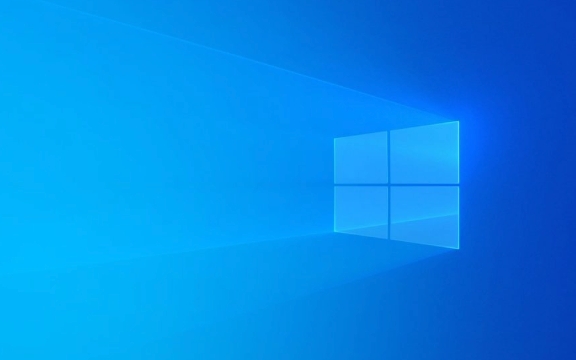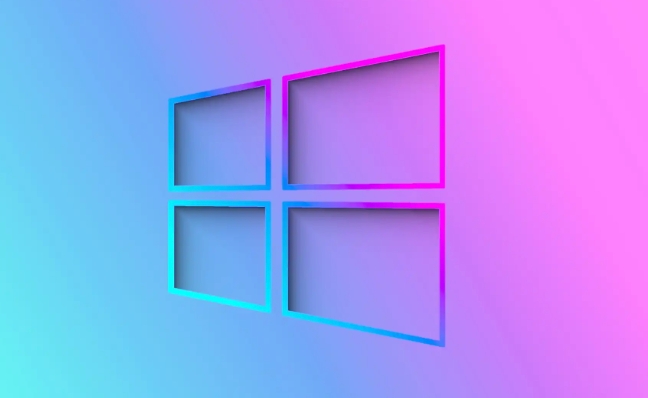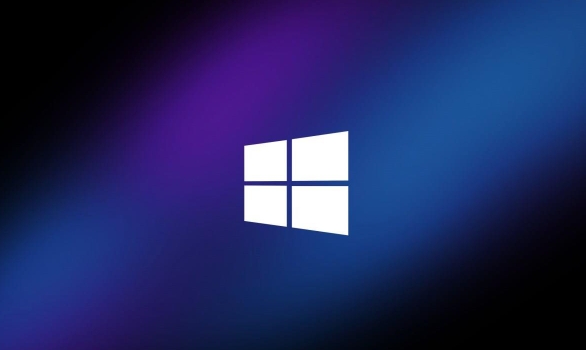 Computer Tutorials
Computer Tutorials
 Troubleshooting
Troubleshooting
 How to troubleshoot a slow internet connection on a Windows PC?
How to troubleshoot a slow internet connection on a Windows PC?
How to troubleshoot a slow internet connection on a Windows PC?
Aug 06, 2025 am 01:05 AMFirst, check your internet speed using speedtest.net or fast.com and compare results with your ISP’s promised speeds, testing on another device to confirm if the issue is isolated to your PC. 2. Restart your network equipment by powering off your PC, modem, and router, waiting 30 seconds, then turning on the modem, followed by the router, and finally your PC to clear temporary glitches. 3. Run the Windows Network Troubleshooter via Settings > System > Troubleshoot > Other troubleshooters > Internet Connections to automatically detect and fix common network issues. 4. Update or reinstall network drivers through Device Manager by expanding Network adapters, right-clicking your adapter, selecting Update driver, or uninstalling it and restarting your PC for automatic reinstallation. 5. Check for bandwidth-hogging applications in Task Manager under the Processes tab sorted by Network usage, identifying and closing high-usage apps like cloud sync tools, streaming services, or game clients. 6. Disable background apps and manage Windows Update settings by going to Settings > Apps > Advanced app settings > Background apps to turn off non-essential apps and disabling peer-to-peer updates in Delivery Optimization. 7. Adjust power settings by unchecking “Allow the computer to turn off this device to save power” in the Power Management tab of your network adapter’s Properties and setting Power mode to Best performance in System settings. 8. Switch to a faster DNS server such as Google DNS (8.8.8.8 and 8.8.4.4) or Cloudflare (1.1.1.1 and 1.0.0.1) via Settings > Network & Internet > Wi-Fi > Hardware properties > Edit DNS. 9. Temporarily disable third-party antivirus or firewall software to test if they are slowing the connection, re-enabling them afterward for protection. 10. As a last resort, reset network settings through Settings > Network & Internet > Advanced network settings > Network reset to restore all network adapters and configurations to default, reconnecting to Wi-Fi networks afterward, ensuring most software-related causes are addressed before concluding the issue is hardware-based.

A slow internet connection on a Windows PC can be frustrating, but the good news is that most issues can be resolved with a few systematic troubleshooting steps. Here’s how to identify and fix the problem:

1. Check Your Internet Speed First
Before diving into fixes, confirm the issue is actually on your end.

- Go to a speed test website like speedtest.net or fast.com.
- Run the test and compare the results to what your internet service provider (ISP) promises.
- If speeds are significantly lower, the issue could be with your network or ISP.
Tip: Test on another device (phone or tablet) using the same network. If it’s also slow, the problem is likely not your PC.
2. Restart Your Network Equipment

This simple step fixes many connection issues.
- Turn off your PC, router, and modem.
- Wait 30 seconds, then power on the modem, wait for it to fully connect (all lights stable), then turn on the router.
- Finally, restart your PC.
This clears temporary glitches and resets network handshakes.
3. Run the Windows Network Troubleshooter
Windows has a built-in tool that can detect and fix common problems.
- Press Windows I to open Settings.
- Go to System > Troubleshoot > Other troubleshooters.
- Find Internet Connections, click Run.
- Follow the prompts and apply any recommended fixes.
It might resolve issues like incorrect DNS settings or adapter problems.
4. Update or Reinstall Network Drivers
Outdated or corrupt network drivers can cause slow speeds.
- Press Windows X and select Device Manager.
- Expand Network adapters.
- Right-click your Wi-Fi or Ethernet adapter and choose Update driver.
- Select Search automatically for updated driver software.
If that doesn’t help:
- Right-click the adapter again and choose Uninstall device.
- Restart your PC—Windows will reinstall the driver automatically.
5. Check for Bandwidth-Hogging Applications
Some apps consume a lot of bandwidth in the background.
- Open Task Manager (Ctrl Shift Esc).
- Go to the Performance tab and click Wi-Fi or Ethernet.
- Check current usage. Then go to the Processes tab and sort by “Network”.
- Look for apps using high percentages of bandwidth.
Common culprits:
- Cloud sync tools (OneDrive, Dropbox)
- Streaming apps
- Windows updates (delivery optimization)
- Game clients (Steam, Xbox app)
Close or limit these if they’re not essential.
6. Disable Background Apps and Windows Updates
Windows can slow your connection by downloading updates or syncing in the background.
To limit background apps:
- Settings > Apps > Installed apps > Advanced app settings > Background apps
- Turn off apps you don’t need running in the background.
To manage updates:
- Settings > Windows Update > Advanced options > Delivery Optimization
- You can disable peer-to-peer update downloads.
7. Change Power Settings for Your Network Adapter
Power-saving modes can throttle your network speed.
- In Device Manager, right-click your network adapter and select Properties.
- Go to the Power Management tab.
- Uncheck Allow the computer to turn off this device to save power.
- Click OK.
Also, make sure your PC is not in a power-saving mode:
- Settings > System > Power & sleep > Power mode
- Set to Best performance if needed.
8. Try a Different DNS Server
Slow DNS resolution can make websites feel sluggish.
Switch to a faster DNS like Google DNS or Cloudflare:
- Settings > Network & Internet > Wi-Fi > Hardware properties
- Under DNS server assignment, click Edit.
- Choose Manual, then toggle IPv4 on.
- Enter:
- Preferred DNS:
8.8.8.8 - Alternate DNS:
8.8.4.4
- Preferred DNS:
- Or use Cloudflare:
1.1.1.1and1.0.0.1
Click Save.
9. Temporarily Disable Antivirus or Firewall
Sometimes security software can interfere with network performance.
- Disable your third-party antivirus/firewall for a short test.
- Run a speed test again.
If speed improves, check the software’s network settings or consider switching to a lighter solution. Don’t stay unprotected—re-enable it afterward.
10. Reset Network Settings (Last Resort)
If nothing else works, reset your network configuration.
- Settings > Network & Internet > Advanced network settings > Network reset
- Click Reset now and confirm.
This removes and reinstalls all network adapters and resets Wi-Fi, Ethernet, and VPN settings to default. You’ll need to reconnect to Wi-Fi networks afterward.
Basically, slow internet on a Windows PC is often fixable without calling your ISP. Start with simple checks, then work through drivers, background usage, and settings. Most issues stem from software, not hardware.
The above is the detailed content of How to troubleshoot a slow internet connection on a Windows PC?. For more information, please follow other related articles on the PHP Chinese website!

Hot AI Tools

Undress AI Tool
Undress images for free

Undresser.AI Undress
AI-powered app for creating realistic nude photos

AI Clothes Remover
Online AI tool for removing clothes from photos.

Clothoff.io
AI clothes remover

Video Face Swap
Swap faces in any video effortlessly with our completely free AI face swap tool!

Hot Article

Hot Tools

Notepad++7.3.1
Easy-to-use and free code editor

SublimeText3 Chinese version
Chinese version, very easy to use

Zend Studio 13.0.1
Powerful PHP integrated development environment

Dreamweaver CS6
Visual web development tools

SublimeText3 Mac version
God-level code editing software (SublimeText3)
 Windows Security is blank or not showing options
Jul 07, 2025 am 02:40 AM
Windows Security is blank or not showing options
Jul 07, 2025 am 02:40 AM
When the Windows Security Center is blank or the function is missing, you can follow the following steps to check: 1. Confirm whether the system version supports full functions, some functions of the Home Edition are limited, and the Professional Edition and above are more complete; 2. Restart the SecurityHealthService service to ensure that its startup type is set to automatic; 3. Check and uninstall third-party security software that may conflict; 4. Run the sfc/scannow and DISM commands to repair system files; 5. Try to reset or reinstall the Windows Security Center application, and contact Microsoft support if necessary.
 Proven Ways for Microsoft Teams Error 657rx in Windows 11/10
Jul 07, 2025 pm 12:25 PM
Proven Ways for Microsoft Teams Error 657rx in Windows 11/10
Jul 07, 2025 pm 12:25 PM
Encountering something went wrong 657rx can be frustrating when you log in to Microsoft Teams or Outlook. In this article on MiniTool, we will explore how to fix the Outlook/Microsoft Teams error 657rx so you can get your workflow back on track.Quick
 The RPC server is unavailable Windows
Jul 06, 2025 am 12:07 AM
The RPC server is unavailable Windows
Jul 06, 2025 am 12:07 AM
When encountering the "RPCserverisunavailable" problem, first confirm whether it is a local service exception or a network configuration problem. 1. Check and start the RPC service to ensure that its startup type is automatic. If it cannot be started, check the event log; 2. Check the network connection and firewall settings, test the firewall to turn off the firewall, check DNS resolution and network connectivity; 3. Run the sfc/scannow and DISM commands to repair the system files; 4. Check the group policy and domain controller status in the domain environment, and contact the IT department to assist in the processing. Gradually check it in sequence to locate and solve the problem.
 the default gateway is not available Windows
Jul 08, 2025 am 02:21 AM
the default gateway is not available Windows
Jul 08, 2025 am 02:21 AM
When you encounter the "DefaultGatewayisNotAvailable" prompt, it means that the computer cannot connect to the router or does not obtain the network address correctly. 1. First, restart the router and computer, wait for the router to fully start before trying to connect; 2. Check whether the IP address is set to automatically obtain, enter the network attribute to ensure that "Automatically obtain IP address" and "Automatically obtain DNS server address" are selected; 3. Run ipconfig/release and ipconfig/renew through the command prompt to release and re-acquire the IP address, and execute the netsh command to reset the network components if necessary; 4. Check the wireless network card driver, update or reinstall the driver to ensure that it works normally.
 How to fix 'SYSTEM_SERVICE_EXCEPTION' stop code in Windows
Jul 09, 2025 am 02:56 AM
How to fix 'SYSTEM_SERVICE_EXCEPTION' stop code in Windows
Jul 09, 2025 am 02:56 AM
When encountering the "SYSTEM_SERVICE_EXCEPTION" blue screen error, you do not need to reinstall the system or replace the hardware immediately. You can follow the following steps to check: 1. Update or roll back hardware drivers such as graphics cards, especially recently updated drivers; 2. Uninstall third-party antivirus software or system tools, and use WindowsDefender or well-known brand products to replace them; 3. Run sfc/scannow and DISM commands as administrator to repair system files; 4. Check memory problems, restore the default frequency and re-plug and unplug the memory stick, and use Windows memory diagnostic tools to detect. In most cases, the driver and software problems can be solved first.
 Windows 11 KB5062660 24H2 out with features, direct download links for offline installer (.msu)
Jul 23, 2025 am 09:43 AM
Windows 11 KB5062660 24H2 out with features, direct download links for offline installer (.msu)
Jul 23, 2025 am 09:43 AM
Windows 11 KB5062660 is now rolling out as an optional update for Windows 11 24H2 with a few new features, including Recall AI in Europe. This patch is available via Windows Update, but Microsoft has also posted direct download l
 Windows could not start because the following file is missing or corrupt
Jul 07, 2025 am 02:39 AM
Windows could not start because the following file is missing or corrupt
Jul 07, 2025 am 02:39 AM
When the boot prompt is "Windows could not start because of the following fileismissing" 1. You can run bootrec/fixmb, bootrec/fixboot, bootrec/rebuildbcd through the Windows installation media; 2. Check the hard disk connection or use CrystalDiskInfo to detect the health status of the hard disk; 3. If there is a dual system, you can use the bootrec command to rebuild the boot or manually add the boot items; 4. Use PE environment to kill viruses and combine DISM and SFC tools to repair the system files, and the system can be restored in most cases.
 My second monitor is not detected on Windows
Jul 08, 2025 am 02:47 AM
My second monitor is not detected on Windows
Jul 08, 2025 am 02:47 AM
If the second monitor is not recognized by Windows, first check whether the cable and interface are normal, try to replace the HDMI, DP or VGA cable, confirm the plug-in video output port, and test different interfaces to eliminate compatibility issues; then verify the monitor power and input source settings, and connect the monitor separately to test whether it can be recognized; then enter the Windows display settings and click the "Detection" button, or use Win P to switch the display mode, and update the graphics card driver at the same time; finally check the graphics card specifications to confirm whether it supports multi-screen output to avoid exceeding its maximum output capability.





